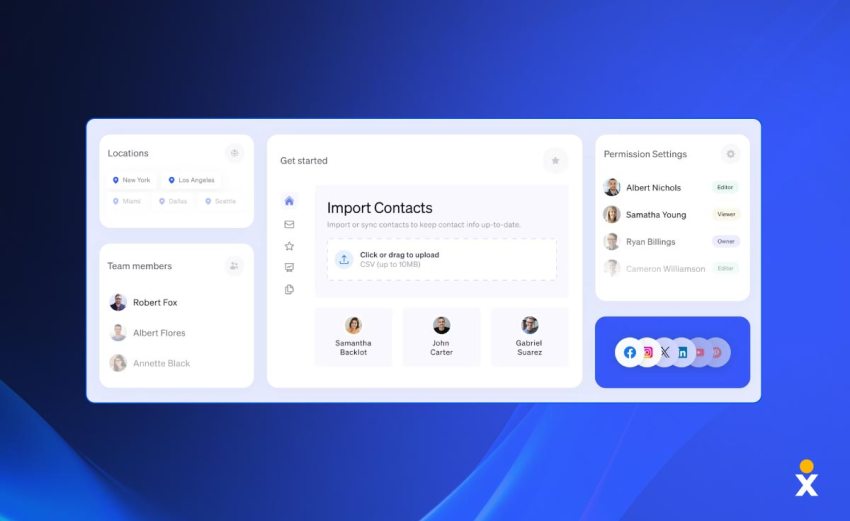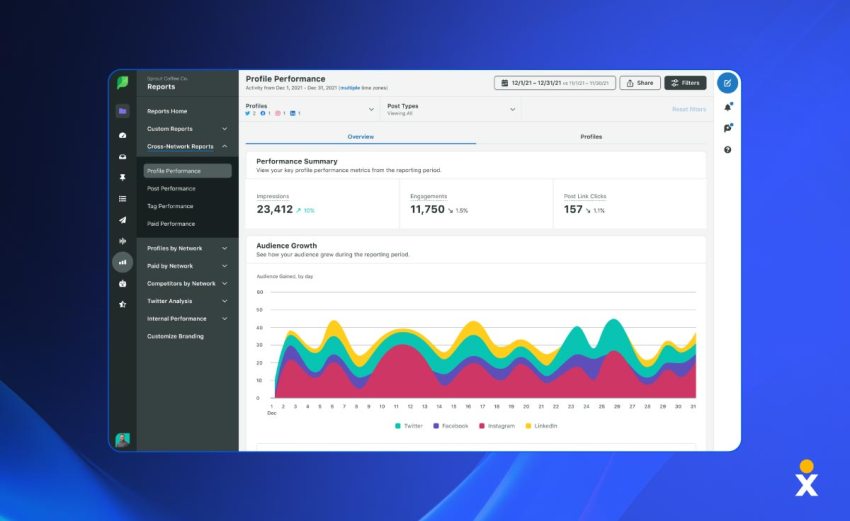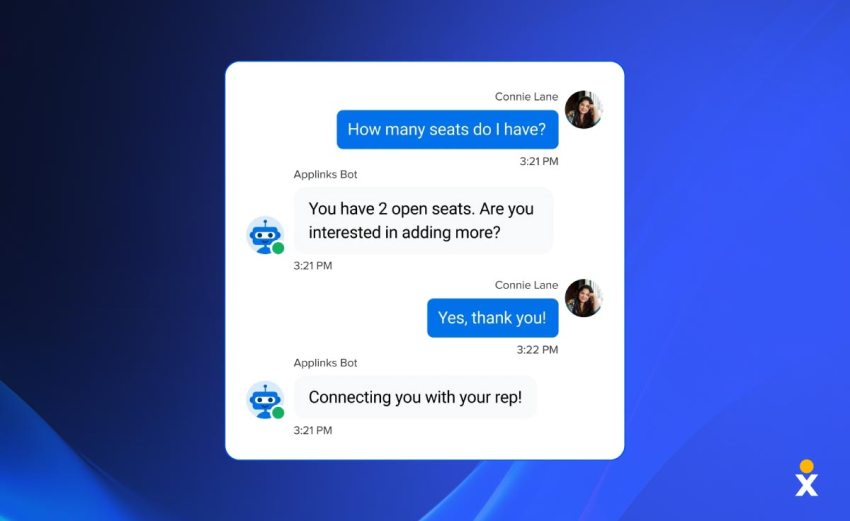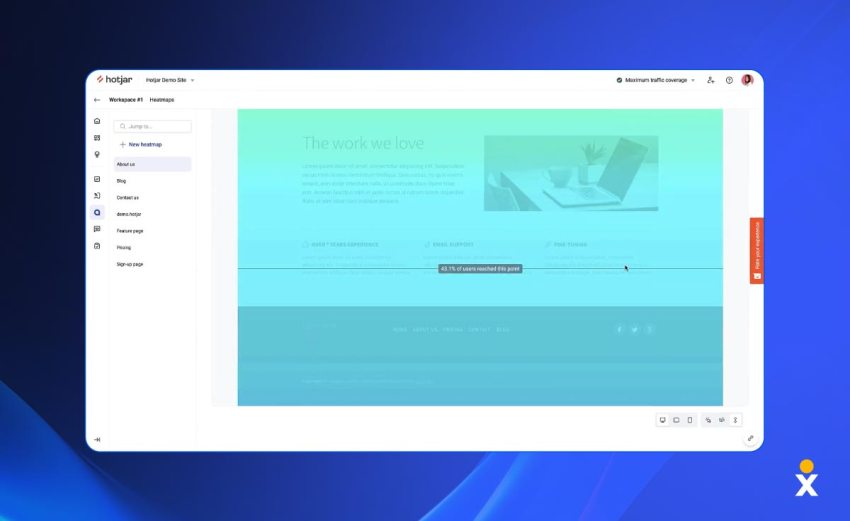Going the extra mile in customer service is standard practice. Customers expect a stellar customer experience (CX) every time they interact with your brand. If they don’t get intuitive, frictionless, and personalized experiences from you, they will turn to a competitor who will.
Positive, engaging interactions can encourage customers to stay longer, increasing retention and revenue. Our guide to the best customer engagement tools can help you pick the right solution to improve customer satisfaction, boost retention, and increase revenue.
Top 15 Customer Engagement Tools for 2026
Here is our pick of the best software from the 15 tools we reviewed:
- Nextiva – Best for unified communications and customer experience management
- LiveChat – Best for live agent customer service
- Typeform – Best for customer surveys and data collection
- Sprout Social – Best for social media engagement
- SurveyMonkey – Best for collecting and analyzing customer feedback
- Drift (Salesloft) – Best for conversational marketing & sales
- HubSpot Service Hub – Best for managing customer support tickets
- Intuit Mailchimp – Best for email marketing campaigns
- Zendesk – Best for omnichannel customer engagement
- Hotjar – Best for tracking visitor behavior
- Qualaroo – Best for customized on-site surveys
- Pushwoosh – Best for cross-platform push notifications
- Twilio – Best for API-driven SMS and voice engagement
- Keap – Best for CRM and account management automation
- Kangaroo – Best for rewards and loyalty programs
What Are Customer Engagement Tools?
Customer engagement tools help businesses communicate, support, and retain customers after a purchase. Employees can easily access customer history through a unified view of all customer touchpoints. Engagement platforms are essential for personalized customer experiences and boost customer loyalty, retention, and revenue.
Omnichannel communication, a unified customer view (CRM), automation and AI-powered insights, powerful analytics, and integration with existing systems are among the key features of the best customer engagement tools.
Differences between customer engagement and customer experience
| Characteristic | Customer Engagement | Customer Experience (CX) |
|---|---|---|
| Definition | The ongoing interactions between a customer and a brand, fostering loyalty and advocacy. | The total of a customer’s perceptions and feelings resulting from all interactions with a brand. |
| Focus | Proactive interactions, two-way communication, building relationships over time. | Holistic journey, ease of use, satisfaction across all touchpoints. |
| Goal | To inspire active participation, loyalty, and repeat business. | To create seamless, positive, and memorable interactions. |
| Tools needed | Live chat, social media monitoring, personalized email campaigns, loyalty programs. | CRM, feedback surveys, journey mapping tools, and knowledge bases. |
Understanding the interplay between these terms is helpful to know.
Customer engagement refers to the ongoing, two-way interactions that build a relationship, such as responding to a social media comment or offering personalized support. Customer experience, on the other hand, is the overarching perception a customer has of your brand across all touchpoints, from initial awareness to post-purchase support.
While engagement tools drive specific interactions, they ultimately contribute to a superior overall CX. So how do you determine the best tools to manage customer engagement?
How We Evaluated the Best Customer Engagement Tools
To put the list of top customer engagement tools together, we evaluated each platform against key criteria for digital customer engagement:
- Key customer engagement features: The scope and depth of the tool’s main features (e.g., chat, social media, CRM, surveys).
- Ease of use: How quickly an average team can learn the platform.
- Integration capabilities: How well the tool connects with other important business systems (CRM, e-commerce, helpdesk).
- Analytics & reporting: The ability to gain actionable insights from customer interactions.
- Pricing & scalability: The tool’s ability to grow with the business and deliver clear, transparent value.
- Customer feedback: User reviews of platforms like G2 and Capterra to understand their actual performance and support quality.
The 15 Best Customer Engagement Tools (In-Depth Reviews)
Here’s a closer look at the best customer engagement tools to try:
1. Nextiva

Best for unified communications and customer experience management
Nextiva unifies AI-driven customer engagement, CRM, and business communications (VoIP) into a unified communications platform. It allows teams to manage the entire customer journey, from the first call to post-sale support, in one place, and offers a complete, unified view of the customer.
Plus, with Nextiva, you have the peace of mind that 24/7 customer support and data encryption can offer.
Key customer engagement features
- Unified Communications: Streamlines all interactions (voice, video, team chat) in a central dashboard, eliminating the need to switch between apps.
- AI-powered customer experience: Use AI for tasks like real-time transcription, call summaries, and optimized routing, connecting customers quickly to the right department.
- Advanced customer analytics: Delivers in-depth, data-driven insights into team performance, customer satisfaction, and interaction history.
- Omnichannel communication: Manages voice and web chat communication with process automation and complete call history.
Integrations: Nextiva integrates with key business tools, including Outlook, Google Contacts, Salesforce, HubSpot, and Zendesk.
What customers are saying about Nextiva
Nextiva’s excellent 24/7 customer service, helpful and competent support team, and solution-oriented approach are highlighted in user reviews and are the main reasons for choosing Nextiva. Users also appreciate the user-friendly platform with its clear interface and high reliability (call quality, availability).
 Pros
Pros
Detailed customer insights
Third-party integrations
Comprehensive reporting dashboards
Unlimited voice and video calls and faxes
 Cons
Cons
Live support limitations
Not suitable for companies outside of the US
Pricing
Nextiva offers a wide range of pricing options depending on your desired features:
- Core at $15/user/month: Includes inbound/outbound calling, business SMS, video meetings, team chat, call routing with a virtual receptionist, and integrations with Outlook/Google contacts.
- Engage at $25/user/month: Adds customer-to-team SMS messaging, a toll-free number, advanced reporting, voice analytics, web chat (live and bot), and voice call/video meeting recording.
- Power Suite CX at $75/user/month: Provides full omnichannel engagement (voice, web chat), process automation, real-time dashboards, AI-powered transcription/summarization, advanced routing, and customer convenience options like web and ACD call back.
All Nextiva plans feature mobile SMS messaging, unlimited voice, and video and audio conference calls.
2. LiveChat

Best for live agent customer service
LiveChat is a dedicated, powerful, and easy-to-use solution for adding a high-quality chat widget to your website. It’s built to help service reps and sales teams interact efficiently with users, offering a clean interface and strong management features.
Key customer engagement features
- Customizable chat widget: Helps create a consistent and familiar brand experience for users on any device.
- Agent tools: Features like canned responses and a typing sneak-peek help agents respond faster and more accurately.
- Detailed reports: Helps managers review agent performance, customer satisfaction, and chatbot effectiveness, including metrics on missed and abandoned chats.
Integrations: LiveChat integrates with over 200 tools, including HubSpot, Salesforce, Zendesk, Mailchimp, and Shopify.
What customers are saying about LiveChat
Users praise LiveChat for its simplicity, reliability, and ease of use, which allows teams to get started quickly. The biggest drawback users cite is the per-agent pricing model, which becomes very expensive as team size increases. Another point of criticism is that the chatbot functionality is not integrated but must be purchased as a separate, costly add-on.
 Pros
Pros
High-quality live chat support
User-friendly interface
Third-party integrations
 Cons
Cons
Lack of notification options if the customer forgets the chat
Limited number of live chat agents
Pricing
LiveChat offers three main pricing tiers depending on how many monthly visitors you want to track:
- Starter: $19/person/month (limit to one seat) for tracking up to 100 monthly visitors
- Team: $49/person/month for tracking up to 400 monthly visitors
- Business: $59/person/month for tracking up to 1,000 monthly visitors
If you need greater tracking capabilities or prefer a dedicated account manager, you can also opt for LiveChat’s Enterprise package.
3. Typeform

Best for customer surveys and data collection
Typeform turns data collection from a tedious task into an interactive, dialogue-driven experience. Its one-at-a-time format is more engaging than traditional forms and leads to higher response rates.
AI-powered assistance allows users to optimize forms and analyze data to gain valuable insights, supported by key performance indicator (KPI) analytics. Ideal for tasks such as customer feedback, lead generation, and market research, Typeform provides businesses with the tools they need to make informed decisions.
Key customer engagement features
- Conversational forms: Presents questions one at a time to create a human-friendly, conversational flow.
- Logic jumps: Intelligently adapts the survey based on user responses, making the experience more personal and relevant.
- Beautiful customization: Allows you to fully tailor colors, fonts, and background images to match your brand’s aesthetic.
With Typeform’s free trial, you can gain access to unlimited forms and more than 3,000 templates to get started.
Integrations: Connects with hundreds of third-party tools, including Google Sheets, Slack, Salesforce, HubSpot, and Mailchimp.
What customers are saying about Typeform
Users praise the appealing, interactive user interface, which leads to higher survey completion rates. The customization options and the ability to integrate branding are also valued. The main criticism is the high price, as many useful features (such as removing the Typeform branding) are only available in more expensive plans.
 Pros
Pros
Ease of use
Ease of creation
Customizability
 Cons
Cons
Pricing
Survey issues
Learning curve
Pricing
Typeform has three core plans to choose from:
- Basic: $25/user/month (limit to one user) for tracking up to 100 monthly responses
- Plus: $50/user/month (limit to three users) for tracking up to 1000 monthly responses
- Business: $83/user/month (limit to five users) for tracking up to 10,000 monthly responses
To unlock more growth with advanced features and support, you can opt for a custom Enterprise package.
4. Sprout Social

Best for social media engagement
Sprout Social is a comprehensive, all-in-one platform for social media management. It offers high engagement rates by consolidating all social media messages from all platforms into a single “smart inbox,” ensuring your team never misses a mention or message.
The platform provides advanced features like performance analytics, AI-powered automation, crisis management, and review monitoring to improve workflows and brand reputation. Team collaboration tools support communication and task management among team members.
Key customer engagement features
- Smart inbox: A unified inbox that centralizes all social media messages, mentions, and tags, making it easy to manage and respond from one place.
- Publishing calendar: Helps teams plan, schedule, and collaborate on social media content in advance.
- Social listening & analytics: Provides deep data on social media performance, audience demographics, and industry trends to inform your strategy.
Integrations: Sprout Social connects with all major social platforms (Facebook, X/Twitter, Instagram, LinkedIn, TikTok, Pinterest) as well as Zendesk, HubSpot, and Salesforce.
What customers are saying about Sprout Social
Sprout Social is known for its powerful and user-friendly interface, which simplifies managing multiple social media accounts. Users also appreciate the versatile publishing and scheduling features, as well as the detailed analytics that facilitate reporting to clients or management. The most cited criticism is the high price, which deters many small businesses and freelancers.
 Pros
Pros
Social listening
Social media management
Post scheduling capabilities
 Cons
Cons
Missing features
Pricing
Some scheduling issues
Pricing
Sprout Social’s pricing tiers include:
- Standard: $199/seat/month for small teams with 5 social profiles
- Professional: $299/seat/month for high engagement and includes unlimited social profiles
- Advanced: $399/seat/month for AI-powered social media management features
- Enterprise: Contact Sprout Social for customized pricing
Sprout Social also offers a free 30-day trial so you can test out its features.
5. SurveyMonkey

Best for collecting and analyzing customer feedback
SurveyMonkey is one of the best-known and most powerful survey tools on the market. It offers more than just simple forms and features powerful AI-powered functions for guidance, analysis, and results distribution — ideal for detailed feedback analysis.
Key customer engagement features
SurveyMonkey offers several features to pique customer engagement, including:
- AI-powered guidance that allows for faster survey questions and unique recommendations to avoid response bias.
- Targeted questions that trigger based on the user’s time on the page, pages viewed, or visit frequency.
- Skip logic to add or remove survey questions based on the responses given by the user.
In addition to creating and distributing surveys, SurveyMonkey can help you analyze responses and generate reports summarizing them.
Integrations: SurveyMonkey connects with tools like Mailchimp, Salesforce, HubSpot, Microsoft Teams, and Slack.
What customers are saying about SurveyMonkey
SurveyMonkey is considered user-friendly, simple, and quick for creating and conducting standard surveys. The analyses are insightful and easy to understand. As with Typeform, the biggest drawback is the high price for small businesses. Even the free plan is perceived as very limited.
 Pros
Pros
User-friendly interface
Extensive survey templates
Survey customization capabilities
Third-party integrations
 Cons
Cons
No free trial period
Limited customer support
Pricing
If you’re a solopreneur or have a very small team with no need to share control of surveys and data, you might opt for an individual plan. But if you want to take advantage of survey sharing with different team members, SurveyMonkey offers two Team Plans that start at three users per plan:
- Team Advantage: $30/user/month starting at 3 users and 50,000 responses per year
- Team Premier: $92/user/month for 100,000 responses per year
- Enterprise: Contact SurveyMonkey for pricing and custom response limits
6. Drift (now, Salesloft)

Best for creating customer communication strategies
Drift pioneered the conversational marketing category. It’s an AI-powered platform designed to engage with high-intent website visitors in real-time, qualify them as leads, and automatically book meetings for your sales team.
Key customer engagement features
- Conversational AI: Engages website visitors 24/7, answers complex questions, and qualifies leads without human intervention.
- Playbooks: Out-of-the-box automations that allow you to create different conversational strategies for different pages or visitor segments (e.g., pricing page visitors vs. blog readers).
- Buyer intent data: Analyzes user behavior to identify high-converting communication strategies and target accounts that are ready to buy.
Drift also offers email automation and analytics tools to help you personalize your customer interactions.
Integrations: Drift integrates with Salesforce, HubSpot, Marketo, and other major marketing automation and CRM platforms.
What customers are saying about Drift
Besides the features themselves, a serious security incident (in August/September 2025), in which login credentials were stolen and customer data from Salesforce was exposed, was a central topic in customer discussions in 2025. Users appreciate the real-time AI for lead qualification and appointment scheduling, but the recent security incident has severely damaged customer trust.
 Pros
Pros
Automatic lead collection
Comprehensive reporting dashboards
Third-party integrations
 Cons
Cons
More expensive than competitors
Limited functions for teams outside the Enterprise plan
Pricing
Drift has only one price package for small businesses. Contact Drift (Salesloft) for custom pricing.
7. HubSpot Service Hub

Best for managing customer support tickets
Service Hub is a strong customer support platform fully integrated with HubSpot’s ecosystem (Marketing Hub, Sales Hub, and a free CRM). This tight integration provides a complete view of every customer interaction, from their first marketing email to their latest support ticket.
Key customer engagement features
- Integrated ticketing: Organizes all customer inquiries from chat, email, and web forms into one unified help desk that’s connected to the CRM.
- Customer portal: A secure portal where customers can track the status of their tickets and review past conversations.
- Knowledge base: An easy-to-build, self-service library of help articles that empowers customers to find answers on their own.
Integrations: Natively integrated with the entire HubSpot suite, plus connects to Slack, Jira, Salesforce, and hundreds of other apps.
What customers are saying about HubSpot Service Hub
Users appreciate the centralized access to all customer communication (tickets, chat, email) in one place, especially the integration with the free HubSpot CRM. The automation features and knowledge base are also popular. Common criticisms include that the ticketing system can be too simple for complex support workflows and that the advanced features require a learning curve.
 Pros
Pros
Fully-integrated CRM software
Detailed customer insights
Service-level agreements for transparency
 Cons
Cons
Limited automations
Costly onboarding fee
Pricing
You can choose from the following Service Hub pricing tiers for your business:
- Starter: $9/seat/month with 500 HubSpot credits.
- Professional: $90/seat/month for 3000 HubSpot credits; $1,500 one-time onboarding fee
- Enterprise: $150/seat/month for 5000 HubSpot credits; $3,500 one-time onboarding fee
Service Hub also offers a free plan to give the product a test run or individual plans if you’re a solopreneur or a very small business.
8. Intuit Mailchimp

Best for email marketing campaigns
Mailchimp has evolved far beyond a simple email newsletter tool. It’s an all-in-one marketing platform that excels at sophisticated, AI-powered email campaigns, customer journey automation, and audience segmentation, thereby strengthening customer loyalty.
Key customer engagement features
- Customer journey builder: A visual workflow builder that lets you create automated, multi-step campaigns based on customer behavior and preferences.
- Generative AI: An Intuit Assist feature helps you generate email copy, segment audiences, and even design visuals, speeding up the campaign creation process.
- A/B testing: Robust testing tools to analyze and optimize subject lines, send times, and content to improve performance.
Intuit Mailchimp also has generative AI to help speed up your email campaign creation process.
Integrations: Connects with hundreds of apps, including Shopify, WooCommerce, Squarespace, and analytical tools like Google Analytics.
What customers are saying about Intuit Mailchimp
It’s praised for its user-friendly drag-and-drop email editor, which is ideal for beginners. However, users don’t like the high pricing model, which doubles the cost for contacts from different lists and includes unsubscribed contacts in the total price. Poor customer service (difficulty reaching a representative) is among the most frequent complaints.
 Pros
Pros
User-friendly interface
Automatic lead collection
Third-party integrations
 Cons
Cons
Unsubscribed users count toward your contact limit
Limitations on the free plan
Pricing
Intuit Mailchimp’s pricing for each of its four tiers changes based on how many contacts you have.
- Free: $0 per month for one seat and audience; up to 500 contacts and 1,000 monthly email sends
- Essentials: $13 per month for three seats and audiences; up to 5000 monthly email sends
- Standard: $20 per month for five seats and audiences; up to 6000 monthly email sends
- Premium: $350 per month for unlimited seats and audiences; up to 150,000 monthly email sends
This pricing reflects each tier at a max of 500 contacts, and the Free tier is only available for up to 500 contacts. For an additional cost, the Essentials tier can accommodate up to 50,000 contacts, and the Standard tier has a limit of 100,000 contacts. The Premium tier doesn’t have a contact limit.
9. Zendesk

Best for omnichannel customer engagement
Zendesk is a market leader in customer service, and for good reason. It provides a robust, scalable, and omnichannel solution that unifies conversations from email, live chat, phone, social media, and more into a single agent workspace.
Key customer engagement features
- Omnichannel support: A unified agent workspace that allows agents to manage conversations across any channel without switching contexts.
- AI and automation: Powerful AI “bots” can handle routine inquiries, and automation workflows (triggers and macros) can streamline repetitive tasks for agents.
- Help center & community forum: A fully integrated knowledge base and community forum that promotes self-service and peer-to-peer support.
Integrations: A massive marketplace with over 1,000+ apps and integrations, including Slack, Jira, Salesforce, and Shopify.
What customers are saying about Zendesk
Zendesk is known as a powerful, scalable, and stable platform for managing omnichannel support. Users appreciate the ability to centrally manage tickets from all channels, as well as the extensive macro (standard response) and automation features. Among the biggest drawbacks are the complex and high pricing structure and the steep learning curve for new users.
 Pros
Pros
Integration marketplace
Customer support
Ease of use
 Cons
Cons
High pricing
Ticketing issues
Some complex customizations
Pricing
Zendesk has four pricing tiers for its customer service platform:
- Support Team: $19/agent/month with email and ticketing support
- Suite Team: $55/agent/month with AI-powered functionality
- Suite Professional: $115/agent/month with customisable reporting and real-time insights
- Suite Enterprise: $169/agent/month with AI change management tools
Zendesk also offers a 14-day free trial with full access to all of its features.
10. Hotjar

Best for tracking visitor movements
Hotjar provides qualitative insights that quantitative tools like Google Analytics cannot. It helps you understand why visitors behave in certain ways by visually representing their mouse movements, clicks, and scrolling.
Key customer engagement features
- Heatmaps: Visually aggregates user behavior, showing you exactly where users click, move their mouse, and how far they scroll on any page.
- Session recordings: Provides real-time recordings of actual visitor sessions, allowing you to watch their entire journey — including where they get stuck or frustrated.
- Feedback & surveys: Simple on-page widgets to collect instant feedback and survey responses from users about their experience.
Hotjar requires a bit of coding, so you should make sure someone on your team has developer experience.
Integrations: Connects with Google Analytics, HubSpot, Slack, Microsoft Teams, and other analytics and collaboration tools.
What customers are saying about Hotjar
Users describe heatmaps and session recordings as invaluable tools that facilitate understanding user behavior. The ease of setup and operation is also praised. Among the few criticisms are the sometimes slow dashboard rendering with large datasets and the potentially high costs for high-traffic websites.
 Pros
Pros
Detailed customer insights
Accurate heat mapping
Real-time session recordings
Third-party integrations
 Cons
Cons
Difficult user interface
Limited customer support
Pricing
- Free: $0 monthly for up to 20k monthly sessions and seven integrations
- Growth: $40 monthly starting on 7k monthly sessions with unlimited surveys and nine integrations
- Pro: Custom pricings starting on 1m monthly sessions with 115+ integrations
- Scale: Custom pricings for 3-month session replay retention and digital experience monitoring
11. Qualaroo

Best for creating customized surveys
Qualaroo (from ProProfs) specializes in contextual, nudge surveys. Instead of sending a survey via email, Qualaroo lets you ask small, targeted questions to visitors while they’re actively on your site, leading to highly relevant, in-the-moment feedback.
Key customer engagement features
- Targeted nudges: Triggers surveys based on user behavior, such as time on page, pages viewed, or exit intent (e.g., “What’s stopping you from purchasing today?”).
- Exit surveys: A great way to gain insight into failed conversions and cart abandonment.
- NPS surveys: Can embed Net Promoter Score® (NPS) surveys at key touchpoints in the customer journey.
Integrations: Connects with Salesforce, HubSpot, Google Analytics, and more.
What customers are saying about Qualaroo
The nudge system is most praised because it enables highly targeted, context-based surveys on a website (e.g., exit-intent surveys). This generates more valuable feedback than email. The main criticisms are the high costs and the lack of user-friendliness, with a cumbersome interface and rigid templates.
 Pros
Pros
Survey customization capabilities
Third-party integrations
 Cons
Cons
Limited starting survey templates
Difficult user interface
No live customer support
Pricing
Qualaroo offers a free tier and three paid tiers:
- Free: $0 for up to 50 survey responses
- Essentials: $19.99 monthly for 1000 email sends and unlimited responses
- Business: $49.99 for 5000 email sends & 100k pageviews
- Enterprise: Starts at $149.99 for custom email sends & pageviews
12. Pushwoosh
Best for cross-platform user engagement
Pushwoosh excels at engaging users outside of your website, primarily through push notifications (web and mobile), email, and in-app messages. It’s built to nurture leads and increase retention by delivering targeted messages at the right time.
Key customer engagement features
These are some of Pushwoosh’s popular features.
- Omnichannel messaging: Supports targeted messages across push notifications, in-app messages, email, SMS, and WhatsApp.
- Advanced segmentation: Allows you to create highly targeted segments based on user behavior, demographics, and other criteria.
- Customer journey builder: A visual designer to automate complex communication journeys to nurture leads and boost conversion rates.
Pushwoosh also supports data security and compliance, adhering to standards like GDPR and CCPA.
Integrations: Connects with Adobe Analytics, Google Analytics, Salesforce, and various e-commerce platforms.
What customers are saying about Pushwoosh
Users find the platform user-friendly and praise the excellent customer support. The segmentation and customer journey features are considered powerful for omnichannel communication. The most frequent criticisms concern the unreliable or faulty reporting and analysis functions, as well as the sometimes slow dashboard.
 Pros
Pros
Easy setup
Customer service
 Cons
Cons
Reporting issues
Technical expertise required
Dashboard Issues
Pricing
Pushwoosh offers a usage-based pricing model, with costs varying depending on the number of users, features, and planned use of the email channel. There is also a free plan for up to 1,000 users with limited functionality.
13. Twilio
Best for SMS and phone engagement
Twilio is not an out-of-the-box software, but rather a powerful API platform that lets developers build any kind of communication experience imaginable. It’s the engine behind the SMS, voice, and video chat for companies like Uber, Airbnb, and Netflix.
Key customer engagement features
- Flexible APIs: Gives developers total control to build custom SMS notifications, IVR (Interactive Voice Response) systems, video chat apps, and more.
- Global scale: A massive global network that ensures reliable message and call delivery anywhere in the world.
- Pay-as-you-go: A flexible pricing model that is highly scalable, allowing you to pay only for what you use, from 10 messages to 10 million.
Integrations: As an API-first platform, it’s designed to be integrated into any custom application. It also has a Twilio SendGrid product for email.
What customers are saying about Twilio
Developers praise Twilio for its powerful, flexible, and reliable APIs, which allow them to build virtually any custom communication solution (SMS, voice). The usage-based billing model is also considered flexible. The biggest drawback is that it’s not an out-of-the-box solution; implementation requires in-depth developer knowledge, and support for the free plan is limited.
 Pros
Pros
Customization options
WhatsApp and Telegram engagement
API integrations
 Cons
Cons
Technical issues during phone calls
Dev knowledge is required for some customizations
Pricing
Twilio uses a pay-as-you-go model for these communication channels:
- SMS: Starts at $0.0083 to send or receive a message
- WhatsApp Business API: Starts at $0.005 to send or receive WhatsApp messages
- Voice APIs: Starts at $0.0085/min to receive and $0.014/min to make a call
- Twilio SendGrid Email API: Starts at $19.95/month
- Twilio SendGrid Marketing Campaigns: Start for free with 6,000 emails/month. Paid plans start at $15/month
- Lookup: Starts at $0.01 per inbound caller identification request. Prices vary by request type
- Video API: Starts at $0.004/min to receive or make a video call
14. Keap
Best for personalizing account management
Keap (by Thryv) is a CRM, sales, and marketing automation platform built for small businesses and service providers. It helps personalize account management by automating follow-ups, lead nurturing, and client onboarding.
Key customer engagement features
- Automation builders: Easy-to-use when/then automation for repetitive tasks like email follow-ups and appointment reminders.
- Visual sales pipeline: A Kanban-style lead dashboard that lets you capture, organize, and move leads through your sales funnel.
- Business phone number: Includes a dedicated business line that can send automated replies to missed calls.
Integrations: Connects with thousands of third-party apps, including Gmail, Outlook, Zapier, and more.
What customers are saying about Keap
Users appreciate the combination of CRM and marketing/sales automation for small businesses. However, the steep learning curve is frequently criticized. Another point of criticism, mentioned in many user reviews, is the inadequate customer service and billing problems; some users even report difficulties canceling their accounts.
 Pros
Pros
Automatic lead collection
Combined sales and marketing automations
 Cons
Cons
Difficult user interface
Costly fees with some integrations
Pricing model increases with your contact list size
No free trial period
Pricing
Keap plans vary by the number of users and contacts, starting at $299/mo for a minimum of 2 users and 1500 contacts.
15. Kangaroo Rewards
Best for rewards and loyalty programs
Kangaroo Rewards is a specialized engagement tool focused on one thing: customer loyalty. It provides businesses, particularly retailers, with an easy-to-implement digital rewards program to encourage repeat business and advocacy.
Key customer engagement features
Kangaroo offers features such as:
- Loyalty and rewards: A simple system where customers can earn points for purchases or actions (like referrals) and redeem them for rewards.
- Marketing automations: Helps you run targeted campaigns (email, SMS, push) to loyalty members about special offers, bonus points, and new products.
- Insights and analytics: Provides data on customer behavior, top-spending members, and promotion effectiveness to help you refine your strategy.
Integrations: Connects with popular e-commerce and POS systems like Shopify, WooCommerce, and Lightspeed.
What customers are saying about Kangaroo
Kangaroo Rewards is praised for its excellent and responsive customer support. Users appreciate the easy setup and integration with e-commerce platforms like Shopify. The flexibility in creating customized, tiered loyalty programs is one of its greatest strengths. The main drawback cited is the sometimes high price for small businesses.
 Pros
Pros
Great customer service
Integrates with Lightspeed POS systems
Advanced loyalty programs
 Cons
Cons
Clunky interface
Poor video quality
Pricing
Kangaroo has four pricing choices:
- Core: $79 monthly for small businesses starting with loyalty
- Plus: $199 monthly for growing brands scaling engagement
- Elite: $349 monthly for brands needing more control
- Enterprise: Custom pricing for large organizations running loyalty across regions, teams, and tech stacks
How To Choose the Right Customer Engagement Tool
Not all user engagement tools are alike. You need a tool that helps you understand your customers’ behaviors while allowing you to adapt strategies on the fly. A tool that helps manage CX in multiple ways will have long-term relevance, giving you forward-thinking insights and helping future-proof your CX strategy.

The best customer engagement management tools have:
- Seamless integrations to mesh with your existing business systems
- Professional onboarding to quickly adopt and leverage the tool’s full capabilities
- Omnichannel support for frictionless communication across channels like email, live chat, and social media
- Personalization capabilities to adapt to customer behavior, preferences, and history
- Detailed data analytics and insights to make data-driven decisions that enhance engagement
- Automation and AI to streamline processes like personalized messaging and routing
- Scalability and flexibility to accommodate growing business needs and adapt to changing engagement trends
Together, these qualities help free up internal resources for more meaningful customer interactions. Think about it: If an intelligent virtual agent handles customer engagement at lower-priority touchpoints, your team has more bandwidth to address high-priority tasks and solve more complex problems.
Whether you’re an entrepreneur just starting or managing a growing small business, finding the right tools can significantly impact your customer relationships.
Many options presented here offer flexible pricing and intuitive interfaces, making advanced customer engagement accessible even with limited resources. Pay close attention to individual tool pricing tiers (e.g., ‘Starter’ or ‘Basic’ plans) and note ease of use, as these are often key indicators of small-business suitability.
Trends for Customer Engagement Platforms in 2026
Customer engagement platforms are changing fast as businesses look for better ways to connect with customers. In 2026, several major trends are driving how companies build and manage customer relationships.
1. Unified customer experience
Companies are bringing all customer and multichannel touchpoints together in one place. Phone, chat, email, and social media interactions now appear in a single dashboard to help support teams view complete histories, understand customer needs and behavior, and respond faster.
It also reduces data silos and keeps communication consistent across various channels. Many platforms also include a ticketing system for smoother management and a drag-and-drop interface that makes setup more user-friendly.
2. Personalization through data
Businesses are using customer data to create more personalized experiences. Instead of depending on broad segments, they use real-time information such as browsing patterns, purchase history, and user preferences.
This level of personalization increases retention, strengthens loyalty, and improves customer success rates. SaaS-based platforms make it easy for new users to customize their use cases and align personalization features.
3. Automation for faster service
Automation has become an important part of customer engagement solutions. With features like automated replies, workflow triggers, and smart routing, teams save time, reduce manual effort, and respond to customers faster. AI agents now handle routine requests such as order tracking or password resets automatically, freeing support teams to focus on complex conversations that need human judgment.
4. Integration with business tools
Modern engagement platforms integrate smoothly with tools that teams already use, including CRM (customer relationship management), marketing, and analytics tools. These integrations provide businesses with a unified view of each customer interaction, from first contact to ongoing support. They also simplify lead follow-ups, performance tracking, and help you manage customer relationships better.
5. Omnichannel communication
Customers expect consistent communication across every channel they use. Whether they contact a business through phone, chat, SMS, email, or social media, engagement platforms maintain message continuity across all channels. Omnichannel communication ensures that customers can move from one platform to another without repeating information, which improves both convenience and customer satisfaction.
6. Real-time analytics
Real-time analytics give companies instant visibility into customer interactions. Managers can monitor response times, satisfaction scores, and resolution rates immediately. This live feedback helps teams focus on performance gaps quickly and make improvements that lead to faster service and better outcomes with improved team performance.
7. Strong security and compliance
Security has become a central requirement for all engagement platforms. Modern systems protect customer information through encryption, access controls, and compliance with regulations such as GDPR and SOC 2. Businesses evaluate providers based on their ability to secure data and maintain transparency in how that data is stored and processed.
8. Mobile-first design
More customers are engaging through mobile devices, so platforms are adapting to this shift and focusing on mobile-first design. Interfaces are optimized for mobile screens, and integrations with services like WhatsApp and Apple Messages for Business allow faster, more flexible interactions. This mobile-first approach helps companies stay accessible wherever their customers are.
9. Growth of self-service options
Customers prefer finding quick answers without waiting for an agent. Platforms now include self-service tools such as chatbots, FAQs, and detailed knowledge bases that guide users to quick answers. These tools reduce response times, improve productivity, and enhance the user experience. Many solutions use no-code builders that let teams design and publish use cases quickly without technical expertise.
10. Use of experience metrics
Companies track engagement using clear, measurable indicators such as Customer Satisfaction Score (CSAT), Net Promoter Score (NPS), and Customer Effort Score (CES). Tracking these metrics helps businesses understand customer sentiment and improve service quality. By analyzing this data regularly, businesses can refine their communication strategies and deliver better experiences over time.
Level Up Your Customer Engagement With Nextiva
Improving customer retention is easy if you have the right customer engagement tools in place. These tools give you the know-how to see exactly where your CX strategy needs improvement. That could lead to redesigning your site, adding new channel capabilities, or leveling your AI-driven customer service automations.
Dozens of customer engagement platforms can help you grab customers’ attention, but the best ones will help you build truly engaging experiences that lead to higher customer retention and lifetime value.

Surprise and delight customers.
Have conversations with customers the way they prefer to communicate – in a single app.
Net Promoter, Net Promoter Score, and NPS are registered trademarks of Satmetrix Systems, Inc., Bain & Company, Inc., and Fred Reichheld.
Customer Engagement Tools FAQs
For even more on customer engagement tools, review these frequently asked questions.
Positive customer engagement drives better customer loyalty, revenue, and brand reputation.
Loyal customers become repeat buyers and brand advocates, leading to higher customer lifetime value and lower churn. And data backs up the assertion that you should engage customers. More than two-thirds of customers want you to proactively engage them rather than having to come to you.
Customer retention strategies differ between small and large businesses primarily due to differences in company size, resources, and customer base. Small businesses know their customers better and can offer them more personalized, direct support. Large businesses, on the other hand, have more resources to expand their customer retention efforts.
The most common challenges when implementing website engagement tools are:
🔹 Integration complexity lies in linking the new analytics tools with your existing business systems
🔹 Data management maintains your customers’ data privacy and security
🔹 User adoption ensures that your employees are trained and motivated to use the new tools
🔹 Scalability allows the software to scale with your business without compromising performance
Additionally, customer engagement apps can be expensive to implement and maintain.
You can measure the ROI on customer engagement strategies by:
🔹 Setting clear, measurable objectives
🔹 Tracking key customer service metrics
🔹 Analyzing customer data across channels
🔹 A/B testing to compare different strategies
You can also ask for customer feedback through surveys, interviews, and reviews to understand their perception of your engagement strategy and its impact on their experience.

















 Customer Experience
Customer Experience 










